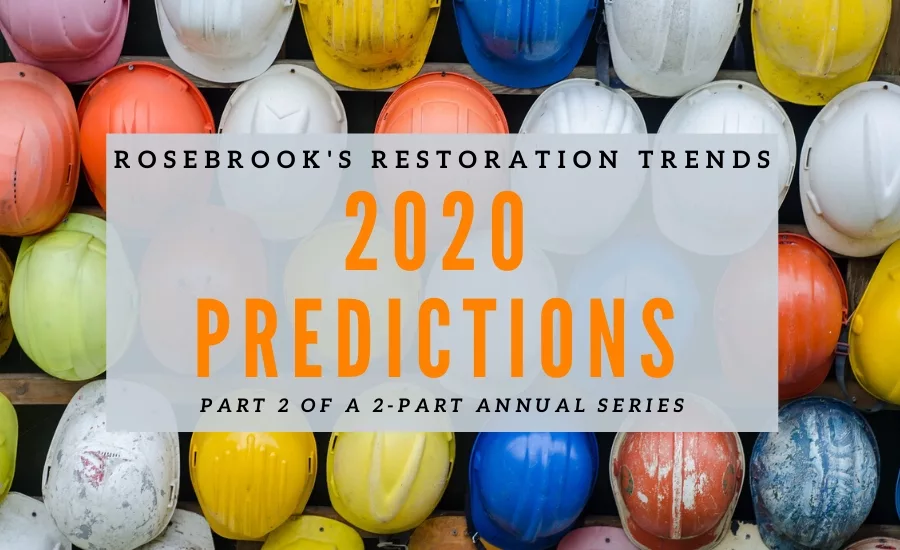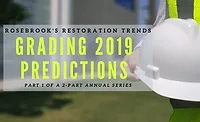Rosebrook's Restoration Trends: 2020 Predictions
Part two of an annual series on current industry trends.

Editor's Note: This is the second of a two-part annual series from Phil Rosebrook of Business Mentors. In part 1, Phil looked back at his predictions for 2019 and to see how his predictions played out. In part 2, Phil offer his projections for the restoration industry in 2020. Enjoy!
Prediction #1: Labor Shortages
Labor shortages is my number one challenge facing the restoration industry in 2020. I have worked with several great companies in the past year that have had to limit their growth due to a lack of good people to fill open roles. This is a function of a national unemployment rate of near 3.5% and much lower in many areas. With the overall lack of available workers, it is essential that your business has a plan to both find new staff and to retain your current workforce.
Recommendations:
- Good people are already working. You will have to find them where they are currently working and convince them that they have a better opportunity in your business and in our industry.
- Take a look at resources for finding good people such as recruiting companies and staffing help.
- Focus on reducing turnover and invest in your existing staff.
- Be selective in your future growth – consider screening your clients and working with the best fits for your organization.
- Utilize technology to improve efficiency. It will take years to come to fruition, but it is evident that technology will replace many jobs. It is important that you create a nimble company, that is able to exist in a changing environment. I predict that many jobs in administration and also estimating will cease to exist in the future. Keep an eye on this trend and create a nimble management structure that can react to this environment when it evolves.
- Expand outside the industry! Find people looking for a new career path. When locating new employees, there has been preference for candidates with industry experience. This is a challenge because in many cases that is not an option, and in other cases, the candidates come with some sort of personal or professional “baggage.” Successful, growing companies are looking outside the industry to locate candidates with the character and work habits that will transition well into the industry.
- If you are hiring outside the industry, then I recommend that you create a strong orientation, on-boarding and internal training program. This will allow you to “fast track” their skills in restoration.
- Provide upward mobility. You can attract great employees – especially at the frontline and mid-level management positions, if you have a clear path for upward mobility, and a career path. Restoration is a great industry, but you will have to tell the story that helps locate and retain great people.
Prediction #2: Consolidation of Systems
In the past decade, many new software systems have been developed for the restoration industry. I think this is the year that the various software programs will start to communicate together, or there will be a further consolidation of suppliers. Next Gear has been at the forefront of this movement. I predict they will continue to consolidate or incorporate new technology into their system. Restoration contractors are working to get more streamlined expectations from vendor programs and also less redundancy from the various insurance companies and TPA’s. This movement is being driven by the PIRC group and also through the RIA’s AGA movement. I do not think that this is a situation that will be solved in 2020, but I do think that there will be progress. For this reason, this will be tough to measure and it is a continuum rather than a destination.
Recommendations:
- Take a look at the outputs from your software systems. Learn if you can accomplish the same, or even more, by understanding the capabilities of your various systems.
- It is my belief that about 80% of the capabilities of most software is not utilized. Restoration companies are always out looking for the next best thing – without properly using what they have. This leads to inefficient system utilization and redundancies in process.
- Take a deep look at the capabilities of your software and the desired results. Connect with other companies that are using the same systems and getting different results.
- If you are increasing your utilization, then you will not need to continue to look for the next best program. There will always be something new. If you have good data and programs are consolidated, then the transition or additional capabilities will be easier to access.
- Work to move closer to a digital company rather than paper-dependent. This will streamline your organization, improve communication and increase efficiency.
Prediction #3: M&A Consolidation
The pace of consolidation in the industry has been remarkable. There are more and more large companies purchasing buying other restoration companies, as well as new equity companies entering the industry. There are no signs of this process slowing. I am not sure if it will increase, or if it can. Over the past year, the acquisitions kept getting larger. I am not sure if it happens this year, or in the next few, but I believe some of the companies that are making many of the purchases will consolidate. As far as I know, there are at least three companies performing more than $1 billion in revenue. There will be more likely this year. Last year, all three of these companies completed very large transactions. Small acquisitions and mergers will continue, but you can expect several very large transactions again this year. I wish I had insider information on this; I do not, just doing my best to read the market.
Recommendations:
- A successful business strategy is to create a salable company the day you open the doors. Even if you have no desire to sell your business, this will make running your company a much easier task. Buyers don’t want a “JOB,” they want to buy a well running company. In the same way, you don’t want a JOB – you want to run a successful business.
- If you want to create a successful and profitable company, then you want to create a market-leading company. This may exist in a niche or could be the overall marketplace. If you are a market leader then your business will be sought out as a target for consolidation – or perhaps will keep outside companies away since it will be a more challenging marketplace to compete in.
- Create a solid team of leaders. If you want to become a target for purchase – or even be a formidable competitor for all comers, then you need to build a great team. This is a function of being a great leader and running an exceptional company. Potential buyers will pay more for a deep bench of strong players. It is important that the company is much strong than just the leader, since the leader may not continue with the company years down the road. If you have great leaders, then your company is more profitable today - and much more valuable to potential buyers.
Prediction #4: AGA Progress
When the idea of the Advocate and Government Affairs movement was imagined, Mark Springer stated in his introduction article that we are in danger of waking up one day and having an unrecognizable industry. The changes that are underway from pricing, to communication and relevance are potentially detrimental to creating a successful and profitable business. This frightening thought caused Mark to layout a clear plan for change to advocate for restoration professionals across the industry. The original article clearly laid out a plan that could salvage the industry as we know it. I don't think that this movement will cover for poor management decisions, but I do think that it takes steps to make your management easier. It is important that this is not seen as an adversarial attack on our clients. That being said, it is essential that we advocate for the professionalism of our industry. The restoration industry is very fragmented and if we do not join together our voices will not be heard. As a group we will be able to create a unified message on issues that impact every one of our businesses.
- I do not expect this movement to have an overnight effect, but I do expect that this will create incremental changes in the following areas:
- More accurate and timely pricing feedback that reflects more realistic market pricing.
- A clear voice that reflects the inherent unfairness of outside third-party evaluators that cause major delays in payment and unfairly cuts pricing of work after it has been complete.
- A unified voice that represents the contractors and reflects the realities of the jobsite needs rather than the opinions of program managers that have not ever been on a restoration jobsite.
- A series of industry position papers that provide support for billing when the contractor is challenged with the statement, “No one else is charging for that!” These position papers will provide a basis for some of the key issues being dealt with by restorers across the country.
- It is my hope that this movement helps create change that will make this a stronger industry that advocates for the customer, a professional project and fair payment for services rendered. I believe that this is a very large undertaking and is getting many skeptical looks. I know the group of leaders that are driving this movement – it consists of many of the best minds in the industry. They are great leaders and fair businesspeople that are advocating for what is right – and should work to create a stronger win-win-win relationship. There are many fragmented groups that are attempting to achieve the same results but do not have a strong and driving vision that has the potential to unify so many, and to respect the voices of the Insurance industry.
- Join the movement and attended the Restoration Industry Association’s annual convention this spring. If you cannot attend, then view the details and updates at www.westorationIndustry.org.
Prediction #5: Unions in Canada
I am not sure if this is a Canadian challenge or if this will make an impact south of the border. I am aware of two shops that have been unionized in 2019. The process for a union taking over a shop in Canada is much easier that in the States. Word on the street is that the unions are looking to make inroads in the restoration industry because it is a good source of labor for their other areas of their union. The union has had success in a national player’s office and a franchise member. I am not certain of the impact that they will have, it is dependent on the companies that are being targeted. As an employer, I am not aware of your abilities to fight the union movement, but I know that there are a lot of rules that need to be followed.
Recommendations:
- Provide a great working culture for your employees so they feel appreciated and valued.
- Provide adequate opportunities for feedback from your frontline staff. Make sure that you solicit their feedback and take actions on issues that deal with safety, working conditions and opportunities. Employees want to have their voices heard and they want to feel “in on things.”
- Reinforce to your staff that you care about them, and create opportunities for their success.
- Create a strong company culture that creates a great atmosphere where employees love to come to work and contribute to something that is bigger than their own position.
Prediction #6: Advances in Technology
Technology is advancing rapidly and is now helping companies create real efficiencies in their businesses. The most obvious trends last year were in the area of estimating and scoping. Matterport and DocuSketch have automated the image capture and sketching process that allow companies to massively improve efficiencies in this area of restoration. I am working with several clients that are using this technology to allow for remote estimators to prepare estimates from their desks. This has always been possible, but the new technology allows for much greater accuracy. If the estimator is able to specialize in writing estimates rather than driving to and from jobsites, then the productivity increases substantially. This technology can be combined with artificial intelligence and machine learning to improve the details and accuracy of the scopes. I understand that Next Gear is working on this technology. I am also aware of a company called Ask Aime that helps identify potential missing items in Xactimate. Technology is also being used to better communicate from the field to the office, and from the restoration company, to the client and the insurance company.
Recommendations:
- Learn the capabilities of your current software and systems. As I stated before, I believe that 80% of most software is underutilized.
- Attend national events and take a learning approach. There are items that will be discussed from the stage and also things to learn from the trade show floor. Take a serious approach to both of these options because it can have massive impact on your business. The final step is to search out the leaders in the industry that have implemented new technologies in their business. Find out what works and also the benefits to their business.
- Look into attending an ‘insuretech’ show to learn about the technology that is being talked about and implemented in the insurance industry. You can learn about these events by reading insurance magazines and blogs.
- Look at trends in other industries to see how they are handling situations that we may encounter in restoration: Remote estimating, dimensioning, materials handling, project management, data collection, labor efficiencies, cost savings, client communication and more.
- Read! Locate relevant blogs, technology magazines, books, tends magazines and newsletters. Since the pace of change is accelerating, it is important to be aware of issues that can and will impact your business. The insurance industry is following the same process and will drive some of the changes required by restorers.
Other Trends to Watch:
It is not likely a 2020 issue – but it will be in the next several. You should keep an eye on blockchain technology. Blockchain will allow for effective and secure communication between several parties without additional needed technology. Blockchain is the technology that is behind Bitcoin – but it is much bigger than that. This will likely transform our economy and the systems and resources that we have become accustomed to for everyday transactions. Your clients will likely find you, compare your services and potentially pay for your services using Blockchain technology. Many insurance companies are aware of the potential for blockchain technology and will be integrating into their businesses in the next 2-10 years (I know that is a big timeframe – but I suspect that this will take on several iterations and even some creative destruction before it is widely adapted.)
The disaster restoration industry is moving quickly. Many new players and influences are driving change. I suspect that the above trends will impact many different areas of your personal life and your business. I recommend you put on your seat belt and get ready for a fun ride.
Wishing you the best in 2020 and if you need assistance in developing a plan to meet these changes head-on and assure your success - contact Business Mentors – we have been helping create successful restoration companies since 1997.
Looking for a reprint of this article?
From high-res PDFs to custom plaques, order your copy today!





